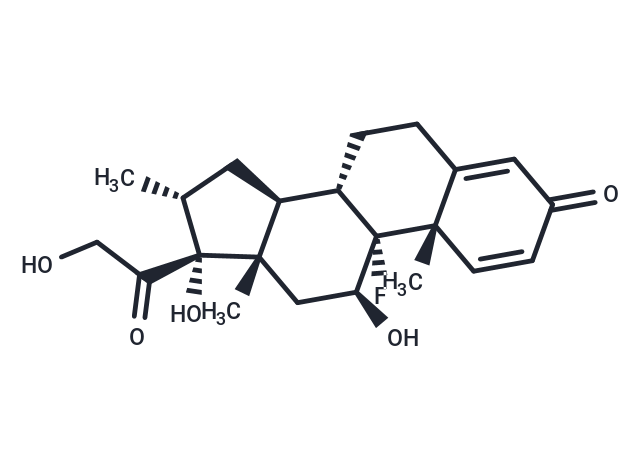Shopping Cart
- Remove All
 Your shopping cart is currently empty
Your shopping cart is currently empty

Dexamethasone (Hexadecadrol) is a glucocorticoid receptor agonist and IL receptor modulator with anti-inflammatory and immunosuppressive properties that induces autophagy and inhibits LPS-induced inflammatory responses in macrophages.

| Pack Size | Price | Availability | Quantity |
|---|---|---|---|
| 50 mg | $29 | In Stock | |
| 1 mL x 10 mM (in DMSO) | $45 | In Stock |
| Description | Dexamethasone (Hexadecadrol) is a glucocorticoid receptor agonist and IL receptor modulator with anti-inflammatory and immunosuppressive properties that induces autophagy and inhibits LPS-induced inflammatory responses in macrophages. |
| In vitro | METHODS: Human colorectal cancer cells LoVo and HCT116 were treated with Dexamethasone (10-300 µM) for 72 h. Cell growth inhibition was detected by MTT. RESULTS: Dexamethasone dose-dependently inhibited the growth of LoVo and HCT116 cells, and the inhibition rates of 300 µM Dexamethasone were 52.6% and 58.8%, respectively. [1] METHODS: Acute lymphoblastic leukemia cells RS4;11 were treated with Dexamethasone (100 nM) for 24-36 h. Cell morphology was examined using electron microscopy. RESULTS: In cells treated with Dexamethasone for 24 h, vesicles were surrounded by double membranes, which are characteristic of autophagosomes, and contained membrane structures and/or part of the endoplasmic reticulum or a large amount of cytoplasm. In addition to the appearance of autophagosomes, the nucleus and cell morphology were initially intact, suggesting that autophagosome formation preceded cell death. Dexamethasone induces autophagy. [2] METHODS: Activated mouse and human T cells were treated with Dexamethasone (0.001-10 μM) for 48 h, and PD-1 expression was detected by Flow Cytometry. RESULTS: Dexamethasone enhanced the expression of PD-1 in mouse and human activated T cells. [3] |
| In vivo | METHODS: To investigate the anti-inflammatory effects, Dexamethasone (1-10 mg/kg) was administered as a single intraperitoneal injection to LPS-induced inflammation in C57Bl/6JBom mice. RESULTS: 10 mg/kg Dexamethasone significantly reduced neutrophils in bronchoalveolar lavage fluid.Dexamethasone treatment significantly down-regulated the levels of TNF-α, IL-1α, IL-1β, IL-6, IL-12p40 and MIP-1α mRNA. Dexamethasone exerts anti-inflammatory and antioxidant functions in acute airway inflammation. [4] METHODS: To detect anti-tumor activity in vivo, Dexamethasone (1 mg/kg) was intraperitoneally injected into SCID mice harboring the human myeloma tumor OPM2 five days per week for three weeks. RESULTS: Dexamethasone treatment significantly inhibited the growth of OPM2 tumors, indicating antitumor activity in vivo. [5] |
| Animal Research | NAC was administered at three different doses (10, 100 and 500 mg/kg body weight). At the highest concentration, the acidic pH of the NAC solution was adjusted by adding NaOH. Dexamethasone was administered as a single injection of 1 or 10 mg/kg. Both drugs were dissolved in saline and 400 μl were injected intraperitoneally, either 1 h before or 1 h after LPS exposure. In one experiment, NAC (100 and 500 mg/kg) was injected successively every 4·5 h, starting 1 h before challenge (five injections in total). A control group of LPS-exposed animals were injected intraperitoneally with solvent alone (saline). Intratracheal administration was performed by instillation of 100 μl NAC (50, 100 or 500 mg/kg) or dexamethasone (10 mg/kg) into the lungs of mice anaesthetized with 15 mg/kg Rapinovet (i.v.) [4]. |
| Alias | Prednisolone F, NSC 34521, MK 125, Hexadecadrol |
| Molecular Weight | 392.46 |
| Formula | C22H29FO5 |
| Cas No. | 50-02-2 |
| Smiles | C[C@@H]1C[C@H]2[C@@H]3CCC4=CC(=O)C=C[C@]4(C)[C@@]3(F)[C@@H](O)C[C@]2(C)[C@@]1(O)C(=O)CO |
| Relative Density. | 1.32 g/cm3 |
| Storage | keep away from direct sunlight | Powder: -20°C for 3 years | In solvent: -80°C for 1 year | Shipping with blue ice. |
| Solubility Information | Ethanol: 6 mg/mL (15.29 mM), Sonication is recommended. 10% DMSO+40% PEG300+5% Tween 80+45% Saline: 7.3 mg/mL (18.6 mM), suspension.In vivo: Please add the solvents sequentially, clarifying the solution as much as possible before adding the next one. Dissolve by heating and/or sonication if necessary. Working solution is recommended to be prepared and used immediately. DMSO: 45 mg/mL (114.66 mM), Sonication is recommended. |
Solution Preparation Table | |

Copyright © 2015-2025 TargetMol Chemicals Inc. All Rights Reserved.